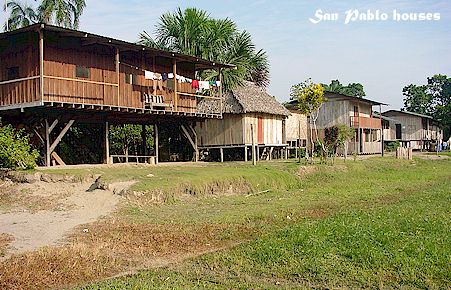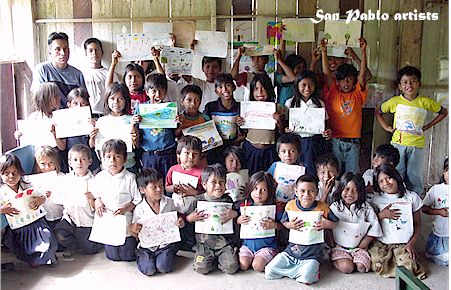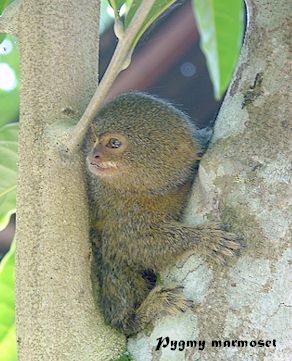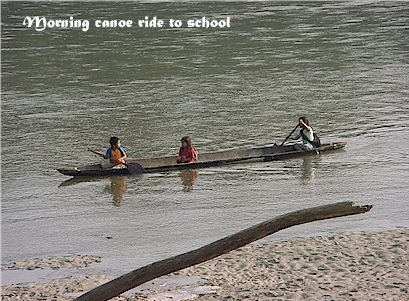Travel E-Logs: Amazon Rain Forest
Travel E-Logs #10: Trip to San Pablo - a Secoya Community
Dear
students,
Greetings from Windhoek, Namibia. That’s right, Lilia and I are no longer
in the Amazon; we’re in Africa! (Teresa is still in Ecuador, but no
longer in the rain forest.) Our Amazon Rain Forest School Project has come
to an end and now we are getting started on our Africa project. But, we wrote
one more travel log for you as we visited San Pablo, another small
village on the Agua Rico, just before we left the rain forest. Here
it is:
Visit to San Pablo
The morning after the fiesta held in our honor in Cuyabeno, Lilia, Teresa
and I headed back up the Agua Rico  River
in a large motorized canoe as the sun rose over the forest (see photo). After
a three hour trip, we stopped at another small village on the river, San Pablo,
and visited there for two days.
River
in a large motorized canoe as the sun rose over the forest (see photo). After
a three hour trip, we stopped at another small village on the river, San Pablo,
and visited there for two days.
San Pablo is a Secoya village. The Secoya people are a distinct
ethnic group with their own language and traditions. Unlike Cuyabeno and other
riverside Quichua villages, which have one small village center and a long
row of houses spread out along the river bank, San Pablo has several small
centers spread out along the river, each with a cluster of houses organized
in two or three straight rows. Like Quichua houses, the houses are built on
wooden stilts to protect them from flooding and they are made of wood with
thatch or tin roofs. The grass in front of the houses is very neatly manicured
and the houses are surrounded by palm trees, flowers and small garden plots.
 San
Pablo, like Cuyabeno, has only one principal road – the river. Most
children who attend the elementary school, La Escuela Ciudad de Otavalo, walk
to school every day; but a few take their own personal ‘bus’ –
a canoe, that is. Lilia, Teresa and I visited Ciudad de Escuela, posted artwork
from US and African schools on the wall of their main classroom, asked the
students questions about their lives posed by a partner class in the US, worked
with students to create artwork for an art exchange and made a video for a
video exchange. One thing we noticed as we were working was that the children
spoke Secoya, their mother tongue, to each other when working or playing together
and the teachers taught most everything in the Secoya language. They learned
Spanish as a subject and could speak it if they had to. This was different
from the Quichua villages we visited where the children mostly spoke Spanish
and the adults spoke Quichua and Spanish.
San
Pablo, like Cuyabeno, has only one principal road – the river. Most
children who attend the elementary school, La Escuela Ciudad de Otavalo, walk
to school every day; but a few take their own personal ‘bus’ –
a canoe, that is. Lilia, Teresa and I visited Ciudad de Escuela, posted artwork
from US and African schools on the wall of their main classroom, asked the
students questions about their lives posed by a partner class in the US, worked
with students to create artwork for an art exchange and made a video for a
video exchange. One thing we noticed as we were working was that the children
spoke Secoya, their mother tongue, to each other when working or playing together
and the teachers taught most everything in the Secoya language. They learned
Spanish as a subject and could speak it if they had to. This was different
from the Quichua villages we visited where the children mostly spoke Spanish
and the adults spoke Quichua and Spanish.
The elementary school has about 45 first through sixth grade students, divided
into two classrooms (though we worked with all the grades at once). The school
has seven teachers, but usually only one or two teachers teach on any given
day.
We also visited the high school and worked with 30 7th through 12th grade
students to create colored drawings of rain forest animals listing the Secoya
and Spanish names of the animals. In the evenings, we  showed
videos from the US, China, Africa and the Arctic to both children and adults.
showed
videos from the US, China, Africa and the Arctic to both children and adults.
Agouti for Dinner
While visiting San Pablo, we stayed with the president of the community, Eliseo,
his wife, Gladys, their two children, Jefferson and Daila and their pet pygmy
marmoset (the smallest kind of monkey in the world, not all that much bigger
than a matchbox, as you can see in the photo). For meals, we ate in a kitchen
that the family shared with their extended family, Eliseo’s parents
and his brothers and their families who lived in nearby houses. For most of
our meals, we ate food that we brought with us from outside San Pablo, but
one night Eliseo and Gladys served us smoked agouti. An agouti is a large
rain forest rodent that lives on the rain forest floor and feeds mostly on
nuts that fall from rain forest trees. Would you eat agouti if it was served
to you? It was quite tasty!
The Chontachuru Diner
Over the years, Lilia and I have eaten a wide variety of interesting and delicious
rain forest foods. Just for fun, I’ve put together a menu of items that
might be served at a rain forest restaurant, The Chontachuru (choan-tah-choo-roo)
Diner. Endangered species, which we wouldn’t recommend eating yet are
nonetheless sometimes eaten in the villages we’ve visited, are marked
with an asterisk (*). The menu items are listed in Spanish or Quichua. After
reading the descriptions of the dishes, see if you can guess what the items
are in English. We’ll list the answers below.
-----------------------------------------------------------------------------------------------------
Appetizers
Frutipan – Boiled starchy nuts with a delicate potato flavor, served
in a buttery sauce.
Wachansu
– Crunchy, football-shaped nuts; collected daily
from the rain forest floor, dried and roasted over an open fire. (Also available
in bulk for export.)
Chontachuru (A.K.A Mayon) -– Our specialty! A perfect starter to get
your appetite squirming. Plump and wriggly with a distinct nutty flavor and
a unique fleshy-oily texture; fattened on fresh palm hearts and plucked daily
from the chonta palm tree. Your choice of fried, roasted or, for the stout
of heart, raw and alive. We bet you can’t eat just one!
Soup of the Day
Masamora de Kutimbo – A grated plantain soup with generous chunks of
kutimbo, an excavating forest floor dweller with tender white meat under its
plates of armor.
Jumbo Wakra Sandwiches
A thick tasty slab of rain forest ‘beef’ cut from your choice
of three rain forest ‘cows,’ with tomatoes, lettuce and mayonnaise
on rye or pumpernickel. Served with a pickle. Choose from the following:
Sachawakra -– The largest land-dwelling mammal in the Amazon.
Kapiwakra – The largest rodent in the world.
*Yakuwakra
– The largest water-dwelling mammal in the Amazon.
Note: wakra means ‘cow,’ sacha means
‘forest’ and yaku means ‘river’ in Quichua.
More Sandwiches
Jumbo Paichi Sandwich – Prefer fish? Same as the wakra sandwiches, but
substitute a paichi steak for the ‘beef.’ Paichi are the world’s
largest freshwater fish.
Sajino Sandwich – Prefer pork? Substitute a sajino ham for wakra or
paichi.
Main Dishes
Fried Raya- – Our fishermen risked one of the most painful stings in
the world to bring this delicacy to your plate.
Maito de Siku con Yuyu – Rodent-lovers, this one’s for you! We’ve
chopped up a giant jumping rain forest rat, mixed it with diced palm hearts,
rolled it up in a fireproof leaf and cooked it over the coals. Garnished with
wachansu. Rodent has never tasted so scrumptious!
Roasted *Chorongo – For those who prefer a traditional dish of Amazon
primate: hunted by blowgun using dart frog poison; roasted whole over an open
fire; a furry, flavorful rain forest favorite.
---------------------------------------------------------------------------------------------------------------
Puzzle
Answers
Here’s the answer the last report’s math puzzler: How many peeps
could three tree frogs peep if three tree frogs could peep without sleep from
three P.M. to three P.M again, at three peeps per second each? Peep-peep-
peep. Have fun fee-guring it out peeper-keepers! And, just for fun, what's
the smallest positive number you could add to the answer to make a number
that is made of all the same digit? At three peeps per second, one tree frog
would make 180 in one minute (3 x 60 seconds), 10,800 peeps in one hour (180
x 60 minutes) and 259,200 peeps in one day (10,800 x 24 hours). So, three
tree frogs peeping at the same rate would make 777,600 peeps in one day (259,200
x 3). If you added 177 to that number you would get 777,777 – a number
made of all the same digit.
The answer to the guess-who poem in the last report is the peccary –
and th e answer to the guess-who photo from the last report is the sting ray.
The items
listed on the Chontachuru Diner menu (above), in English, are as follows:
Frutipan – Bread fruit
Wachansu – Brazil nuts
Chontachuru or Mayon -– Chonta palm tree grubs
Masamora – Soup made of grated plantain
Kutimbo – Armadillo
Sachawakra -– Tapir
Kapiwakra – Capybara
Yakuwakra – Manatee
Paichi – Piracuru
Sajino – Peccary
Raya ---– Sting ray
Maito – Food wrapped in a large fireproof leaf and cooked over coals
Siku – Agouti
Yuyu -- Palm hearts
Chorongo – Wooly monkey
END OF THE TRAIL
Well, that's the end of the trail for this year. We've had lots of fun and
learned a lot -- and hope you have, too. Hope to see you again next year!
Till then....
LEARN LOTS!
Paul, Lilia
and Teresa
Amazon Rain Forest School Project Coordinators
<><><><><><><><><><><><><><><><><><><><><><><><><>
TEACHERS: This is the final report. Thank you for joining us on our tour of
the Amazon! We will be sending evaluation forms soon.
We have posted two new Web site sections, Tur de Quito and Baños: Where the Rain Forest Begins. Both feature Spanish content but are also designed for general classroom use.
| E-Travel Log #1: Introduction to the Project and the Adventure Team |
| E-Travel Log #2: Quito, Banos and Flashbacks of Christmas Celebrations in Limoncocha |
| E-Travel Log #3: Banos - Where the Rain Forest Begins |
| E-Travel Log #4: Limoncocha - A Quichua Community |
| E-Travel Log #5: Limoncocha and Communities Around - Traditions and Cultures |
| E-Travel Log #6: Getting Ready to Leave for Cuyabeno |
| E-Travel Log #7: Rain Forest Animals |
| E-Travel Log #8: Rain Forest Stories and the Mysterious Black Lake |
| E-Travel Log #9: Trip to Playas de Cuyabeno |
| E-Travel Log #10: Trip to San Pablo - a Secoya Community |
